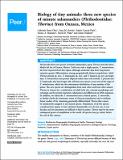Por favor, use este identificador para citar o enlazar a este item:
http://hdl.handle.net/10261/152255COMPARTIR / EXPORTAR:
 SHARE SHARE
 CORE
BASE CORE
BASE
|
|
| Visualizar otros formatos: MARC | Dublin Core | RDF | ORE | MODS | METS | DIDL | DATACITE | |

| Campo DC | Valor | Lengua/Idioma |
|---|---|---|
| dc.contributor.author | Parra-Olea, Gabriela | es_ES |
| dc.contributor.author | Rovito, Sean M. | es_ES |
| dc.contributor.author | García-París, Mario | es_ES |
| dc.contributor.author | Maisano, Jessica A. | es_ES |
| dc.contributor.author | Wake, David B. | es_ES |
| dc.contributor.author | Hanken, James | es_ES |
| dc.date.accessioned | 2017-07-03T08:12:00Z | - |
| dc.date.available | 2017-07-03T08:12:00Z | - |
| dc.date.issued | 2016-11-15 | - |
| dc.identifier.citation | PeerJ 4: e2694 (2016) | es_ES |
| dc.identifier.uri | http://hdl.handle.net/10261/152255 | - |
| dc.description.abstract | We describe three new species of minute salamanders, genus Thorius, from the Sierra Madre del Sur of Oaxaca, Mexico. Until now only a single species, T. minutissimus, has been reported from this region, although molecular data have long shown extensive genetic differentiation among geographically disjunct populations. Adult Thorius pinicola sp. nov., T. longicaudus sp. nov., and T. tlaxiacus sp. nov. are larger than T. minutissimus and possess elliptical rather than oval nostrils; T. pinicola and T. longicaudus also have longer tails. All three new species occur west of the range of T. minutissimus, which has the easternmost distribution of any member of the genus. The new species are distinguished from each other and from other named Thorius in Oaxaca by a combination of adult body size, external morphology and osteology, and by protein characters (allozymes) and differences in DNA sequences. In addition, we redescribe T. minutissimus and a related species, T. narisovalis, to further clarify the taxonomic status of Oaxacan populations and to facilitate future studies of the remaining genetically differentiated Thorius that cannot be satisfactorily assigned to any named species. Populations of all five species considered here appear to have declined dramatically over the last one or two decades and live specimens are difficult to find in nature. Thorius may be the most endangered genus of amphibians in the world. All species may go extinct before the end of this century. | es_ES |
| dc.language.iso | eng | es_ES |
| dc.publisher | PeerJ | es_ES |
| dc.relation.isversionof | Publisher's version | es_ES |
| dc.rights | openAccess | es_ES |
| dc.subject | Biodiversity | es_ES |
| dc.subject | Biogeography | es_ES |
| dc.subject | Evolutionary studies | es_ES |
| dc.subject | Taxonomy | es_ES |
| dc.subject | Zoology | es_ES |
| dc.subject | Miniaturization | es_ES |
| dc.subject | Amphibia | es_ES |
| dc.subject | Biogeography | es_ES |
| dc.subject | Systematics | es_ES |
| dc.subject | Endangered species | es_ES |
| dc.subject | Osteology | es_ES |
| dc.subject | Evolution | es_ES |
| dc.subject | Cryptic species | es_ES |
| dc.title | Biology of tiny animals: three new species of minute salamanders (Plethodontidae: Thorius) from Oaxaca, Mexico | es_ES |
| dc.type | artículo | es_ES |
| dc.identifier.doi | 10.7717/peerj.2694 | - |
| dc.description.peerreviewed | Peer reviewed | es_ES |
| dc.relation.publisherversion | http://dx.doi.org/10.7717/peerj.2694 | es_ES |
| dc.identifier.e-issn | 2167-8359 | - |
| dc.rights.license | http://creativecommons.org/licenses/by/4.0/ | es_ES |
| dc.relation.csic | Sí | es_ES |
| oprm.item.hasRevision | no ko 0 false | * |
| dc.identifier.pmid | 27896029 | - |
| dc.subject.uri | http://metadata.un.org/sdg/15 | es_ES |
| dc.subject.uri | http://metadata.un.org/sdg/15 | es_ES |
| dc.type.coar | http://purl.org/coar/resource_type/c_6501 | es_ES |
| dc.subject.sdg | Protect, restore and promote sustainable use of terrestrial ecosystems, sustainably manage forests, combat desertification, and halt and reverse land degradation and halt biodiversity loss | es_ES |
| dc.subject.sdg | Protect, restore and promote sustainable use of terrestrial ecosystems, sustainably manage forests, combat desertification, and halt and reverse land degradation and halt biodiversity loss | es_ES |
| item.openairetype | artículo | - |
| item.openairecristype | http://purl.org/coar/resource_type/c_18cf | - |
| item.grantfulltext | open | - |
| item.fulltext | With Fulltext | - |
| item.languageiso639-1 | en | - |
| item.cerifentitytype | Publications | - |
| Aparece en las colecciones: | (MNCN) Artículos | |
Ficheros en este ítem:
| Fichero | Descripción | Tamaño | Formato | |
|---|---|---|---|---|
| PeerJ 4 e2694 (2016).pdf | 8,96 MB | Adobe PDF |  Visualizar/Abrir |
CORE Recommender
PubMed Central
Citations
5
checked on 24-abr-2024
SCOPUSTM
Citations
17
checked on 19-abr-2024
WEB OF SCIENCETM
Citations
17
checked on 27-feb-2024
Page view(s)
383
checked on 24-abr-2024
Download(s)
233
checked on 24-abr-2024



